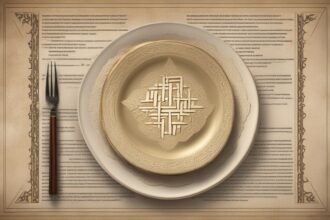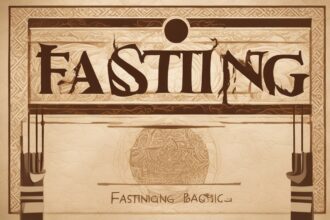The practice of abstaining from food for spiritual or religious reasons has deep historical significance across cultures and faiths. Unveiling the Roots Of Religious Fasting Customs allows us to understand how these traditions have shaped human connection to the divine, self-discipline, and community. This post explores the origins, evolution, and cultural underpinnings of fasting as a sacred act, offering insights into why and how these customs emerged. Join us on this journey through time to uncover the profound history behind fasting practices.
Origins of Sacred Fasting Traditions
The beginnings of fasting as a religious practice can be traced back to ancient civilizations where it was often seen as a means of purification and spiritual connection. In early societies, abstaining from food was believed to cleanse the body and soul, preparing individuals for divine encounters or rituals. For instance, in ancient Egypt, priests fasted before performing sacred ceremonies to achieve a heightened state of spiritual awareness. Similarly, indigenous cultures across the Americas used fasting as part of vision quests to seek guidance from spiritual entities [1]. This shows how deeply embedded the concept of fasting was in early human spirituality, forming a foundation for the Roots Of Religious Fasting Customs we recognize today.
If you’re curious about the broader history of such practices, check out Uncovering Health Fasting: A Fascinating History Journey for more insights.
Ancient Roots of Spiritual Abstinence
In ancient times, fasting was not merely about abstaining from food but was a profound act of devotion and sacrifice. Civilizations like the Greeks and Romans incorporated fasting into their religious festivals, believing it honored the gods and demonstrated piety. In Mesopotamia, fasting was practiced during periods of mourning or to appease deities during times of crisis [2]. What is the significance behind the Roots Of Religious Fasting Customs in these early societies? It often symbolized humility and a willingness to surrender earthly desires for spiritual enlightenment. These ancient practices laid the groundwork for structured fasting rituals in later religious traditions.
Imagine discovering ancient texts that describe how fasting was used to prepare for significant life events or divine prophecies. Such stories reveal the timeless reverence for this practice across generations.
Historical Basis of Religious Restraint
The historical context of fasting reveals its role as a form of religious restraint across major world religions. In Judaism, fasting is central to days like Yom Kippur, the Day of Atonement, where believers abstain from food and drink to seek forgiveness and reflect on their actions. Early Christians adopted fasting as a way to emulate Jesus’ 40-day fast in the wilderness, a practice that evolved into the Lenten season. Meanwhile, in Hinduism, fasting during festivals like Navratri is seen as a way to honor deities and purify the mind [3]. These examples highlight how fasting became a universal expression of faith and discipline in diverse spiritual contexts.
For a deeper dive into historical fasting benefits, explore Fasting Benefits Through Time: A Journey Into Fasting History.
Evolution of Holy Fasting Practices
Over centuries, the practice of fasting evolved to adapt to cultural, social, and religious changes. In Islam, the month of Ramadan became a cornerstone of faith, where fasting from dawn to dusk is one of the Five Pillars, emphasizing community, charity, and spiritual growth. Buddhism also developed unique fasting practices, often tied to monastic life, where monks limit food intake to focus on meditation and mindfulness [4]. The evolution of these holy practices shows how fasting transcends mere abstinence, becoming a structured act of devotion tailored to specific religious doctrines. Understanding this progression helps us appreciate the depth of fasting as a spiritual tool.
Curious about ancient traditions influencing modern practices? Learn more at Unearthing Fasting Roots: Ancient Traditions To Modern Wins.
- Judaism: Fasting on Yom Kippur for atonement and reflection.
- Islam: Observing Ramadan to strengthen faith and community bonds.
- Christianity: Lent as a period of fasting to commemorate Jesus’ sacrifice.
- Hinduism: Fasting during festivals like Navratri for spiritual purification.
- Buddhism: Monastic fasting to enhance meditation and discipline.
Cultural Beginnings of Devotional Fast
The cultural underpinnings of fasting reveal how deeply it is tied to communal identity and devotion. In many African traditional religions, fasting was part of rituals to honor ancestors or seek protection from spiritual forces. In India, regional variations of fasting emerged, with some communities abstaining from specific foods like grains or salt during sacred periods to show devotion. These cultural beginnings often blended with religious practices, creating unique expressions of faith through fasting [5]. This diversity underscores how fasting is not a one-size-fits-all practice but a deeply personal and communal act shaped by local traditions.
Imagine walking through a village during a fasting festival, witnessing how entire communities come together in shared sacrifice and prayer. Such experiences highlight the cultural richness of these customs.
Early Customs in Fasting History
Delving into early customs offers a glimpse into how fasting was practiced before organized religion formalized it. In prehistoric times, fasting might have been a natural response to food scarcity, later imbued with spiritual meaning as societies developed. Among the Zoroastrians of ancient Persia, fasting was practiced to purify the soul before important religious events. Similarly, in early Chinese traditions influenced by Taoism, fasting was linked to achieving harmony with nature and the cosmos [6]. These early customs remind us that fasting has always been a bridge between the physical and spiritual realms, a practice as old as human belief itself.
- Prehistoric fasting: Likely tied to survival, later gaining spiritual significance.
- Zoroastrian practices: Fasting for soul purification before rituals.
- Taoist traditions: Abstinence to align with natural and cosmic forces.
This content is for informational purposes only.
References
- [1] Study on Ancient Fasting Practices in Egypt and Indigenous Cultures, 2023
- [2] Historical Analysis of Fasting in Mesopotamia and Greco-Roman Societies, 2022
- [3] Insights on Fasting in Judaism, Christianity, and Hinduism, 2021
- [4] Research on Islamic and Buddhist Fasting Traditions, 2020
- [5] Cultural Studies on Fasting in African and Indian Traditions, 2019
- [6] Early Fasting Customs in Zoroastrian and Taoist Practices, 2018






